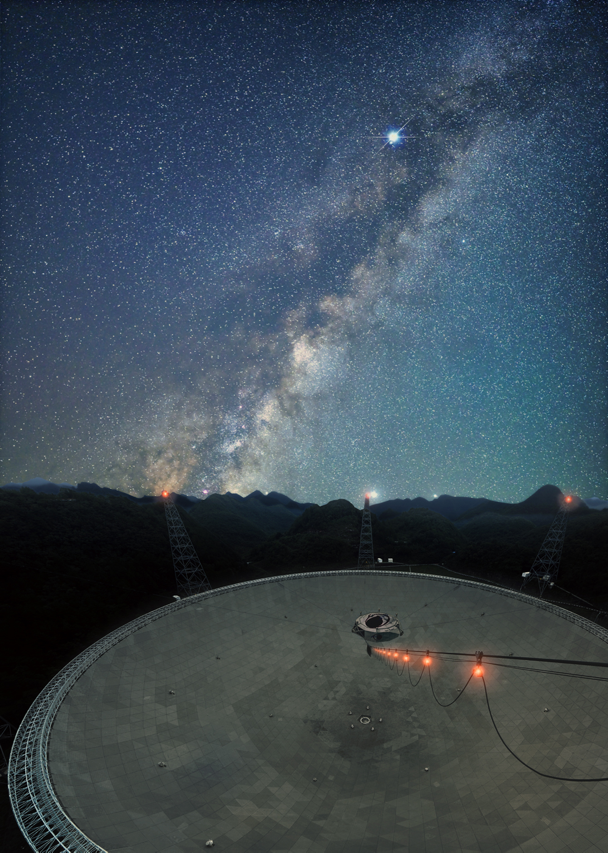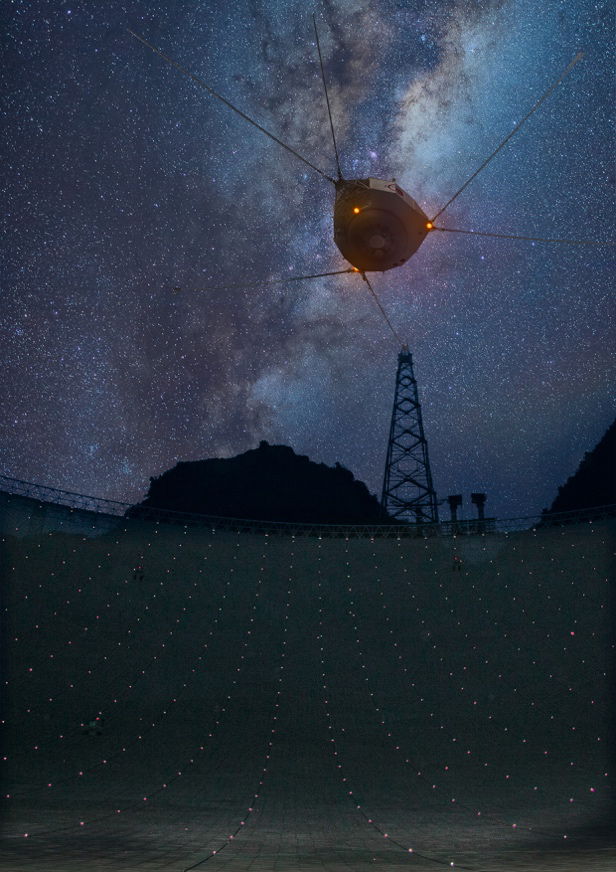
Figure 1:Repeating FRBs were detected with FAST, shown here with the Milky Way in the background (Photograph by Lin Huang, Qingliang Yang, Bojun Wang, Chunfeng Zhang, and Jincheng Jiang. Art by Qisheng Cui)
With the beginning of the Five-hundred-meter Aperture Spherical radio Telescope (FAST) operation, the Chinese Academy of Science immediately made the facility available to astronomers across the country. The sensitivity of FAST helped researchers to detect fainter signals than had ever before been possible. Together with its excellent surface precision and good receiver polarization fidelity, FAST became a unique instrument to carry out follow-up observations for fast radio bursts (FRBs).
Initially discovered in 2007, FRBs are one of the hottest topics in modern astronomical research. It is very perplexing that how and why FRB can radiate such a large amount of energy in millisecond-duration radio pulses. On October 29th and November 4th, 2020, the research journal “Nature” published two articles on FRBs using FAST: 1) “Diverse polarization angle swings from a repeating fast radio burst source” and 2) “No pulsed radio emission during a bursting phase of a Galactic magnetar”.

Figure 2:A photo from the large FAST dish, with the Milky Way in the background (Photograph by Lin Huang, Qingliang Yang, Bojun Wang, Chunfeng Zhang, and Jincheng Jiang. Art by Qisheng Cui)
In the first work, the team identified FRB 180301 as a repeating FRB. This FRB was initially detected by the Parkes radio telescope (in Australia) as a one-time burst. Long-term monitoring of the source revealed rapid swings in the linear polarization position angle (the direction of radio wave oscillation) during the millisecond burst. Debates dating back to the time of the FRB initial discovery that whether the following two sites are the birthplace of FRB radiation. 1) the radio emission of FRB was generated in the magnetosphere of magnetar, i.e. in the space filling with strong magnetic field and ionized particles near a compact star with strong magnetic field. 2) the radiation was produced in the plasma jet due to shock waves. Before the current work, only two one-time bursts showed polarization angle swing and those repeating FRBs had shown flat polarization angle. The data was not enough to test the two propositions. The new discoveries of polarization angle swing in FRB 180301 thus provides new clue to FRB radiation mechanism. Particularly, the magnetospheric models are preferred, and shock wave models are disfavored. The observation provides new insights for the physical mechanism of FRB radiation.

Figure 3:Radio pulses with polarisation angle swing from FRB are detected, which indicates their magnetospheric origin.
In the second work, the team made deep observations towards a galactic FRB candidate, the magnetar SGR J1935+2154, located 30,000 light years away from Earth. In April 2020, CHIME (in Canada) and STARE2 (in US) telescopes had detected ultra-luminous radio burst from SGR J1935+2154, resembling FRB signals. It is highly likely that SGR J1935+2154 is an FRB located in the Milky Way. Given the source is very bright in high energy band, it was speculated that the radio bursts and high energy activities were related. The research team observed SGR J1935+2154 with FAST, providing the most stringent flux upper limit for the radio pulse in the active window indicated by high energy data. The results imply that the condition to generate FRB-like strong radio bursts from the magnetar should be very special.
In both works, researchers from Kavli Institute for Astronomy and Astrophysics (Peking university), National Astronomical Observatory (Chinese academy of science), and University of Nevada formed the core team.
Links to articles:
https://www.nature.com/articles/s41586-020-2827-2
https://www.nature.com/articles/s41586-020-2839-y
PKU News:
https://news.pku.edu.cn/jxky/4b63d7ddc32c493b861d4de24821c325.htm